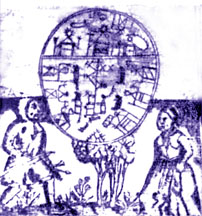
Saami people
("Laplanders") with
sacred drum, northern Scandinavia, 1700s.
Interview by Machete: Online Zines by Women of Color (2001)
::: Did you find a common pattern among women and cultures you featured?
Yes, lots of patterns. Female spheres of power, like clan mothers, elders, healers, diviners, priestesses. The intertwining of social, economic, and spiritual power in indigenous cultures, and the encoding of sacred meaning by potters, weavers, and basketmakers. Very strong similarities between aboriginal religions globally, in the goddess iconography and the kinds of sacraments people celebrated, the reverence for life-consciousness present in everything, and a connection to the ancestors.
Also, political patterns. Mother-right changing to patriarchy. The colonization of women, growing restrictions on our bodies and speech and mobility, a shift in control over the wealth we create along a move to privatization from more communitarian values. Female captives as the pattern in early slavery (which was probably a factor in degrading women's status overall). Patterns of female resistance, how women found ways to subvert patriarchal control. Or to protest it, as in the marriage laments sung in some parts of India and China and Russia, that protested the bride's loss of freedom and the abuse she faced as a wife living among in-laws.
Another thing that stands out is how domination by class and conquest is related to patriarchal controls: for example, how veiling and confinement and footbinding began among aristocratic groups. At the other end, the persistence of female spheres of power among the indigenous peoples and oppressed castes. It's very striking that women leaders of popular uprisings were often shamans, diviners, priestesses.
And one very significant pattern has to do with what information we are given and what is withheld: when African and North American or Southeast Asian cultures get left out of standard histories, then at the same time they are excluding some of the most dramatic instances of female power. Oral histories talking about female leaders or ancestral founders, or the social authority built into female-positive social systems. I'm not saying there is no male domination in those regions I just named. But why do we always hear about the Aztecs instead of the Seri or Zapotecs? How come we so rarely see anything about Sumatra or Yunnan or the Zambezi River, where there are strong woman-honoring traditions?
::: Have you gotten positive or negative responses from women? from men?
I've gotten very enthusiastic responses, overwhelmingly from women, but from men too. Women are certainly the most interested. The one negative response to my web site so far was from a male academic who was incensed at the idea that women developed agriculture, which is hardly controversial anymore.
::: Do you know of any current histories that are "disappearing" even as we speak?
There are a lot of tragic losses happening in the ongoing destruction of indigenous homelands, in the Amazon basin and the rainforests of Kelemantan (Borneo) and other parts of Southeast Asia, in southern Sudan and the Nigerian delta. Logging, oil extraction, land seizure, missionaries, globalized media, all contribute to a continuing wave of economic and cultural genocide. (And outright genocide, too, as in Darfur or in the 70s in Paraguay.) Oral traditions are lost as people are forced to speak the dominant languages, move to the cities, convert to Christianity or Islam, and so on. Some of these threatened cultures are matrilineal, like the Khasi (Assam, NE India), the southern Nuba (Sudan), and the Chama peoples of the eastern Andes.
On the positive side, there are increasingly strong movements to resurrect indigenous culture and revive the languages and religions. This is happening in North and South American, Sibera, Australia, with the Basques and Saami and Lithuanians in Europe. The Berbers in north Africa have been demonstrating this year (2001) for the right to be taught in their own language. And for decades now indigenous groups have been building an international movement to fight for their rights, including sovereignty over their historic lands.
::: Have you considered international collaborations for information collection?
I've done some via email, but don't have the funding for travel. But many women are gathering the information and combing the cultural record of various countries for buried knowledge about women. In the past 30 years, thousands of new books have come out which begin to repair the female exclusion from history, for a multitude of cultures and time periods. So where before we were talking about "disappearing" histories, the erasures that have gone on, here they are "reappearing," being uncovered and gathered and reassembled and examined.